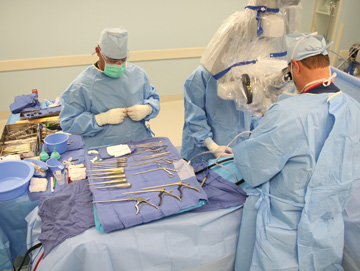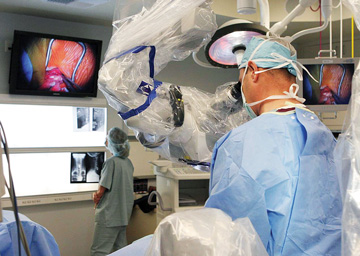In October 2021, Arno Sungarian, MD, UMass Memorial Health neurologic surgeon and assistant professor at UMass Chan Medical School, successfully completed the first outpatient spine procedure at our surgery center, a discectomy at the L3-L4 region.
We’ve performed about five spine surgeries per month since, and plan to slowly increase the number of cases and procedural mix over the coming months and years.
Building a spine service line requires specialty-specific equipment and specially trained surgeons and staff. Additionally, it demands careful and thoughtful planning, understanding local market conditions, and having substantive discussions with
surgeons, anesthesia providers and staff that result in collective agreement on what procedures, equipment and protocols your center will offer, utilize and implement.
Here’s what you’ll need to create a spine surgery facility that is set up to grow steadily and successfully over time.
• Physical space. Your spine ORs should be roomy, but they don’t need to be enormous. At 520 square feet, each of our facility’s nine ORs were built to be specialty-agnostic. They are large enough to accommodate total joints
procedures, which we added right before the pandemic hit and with which we’ve experienced great success. Currently, we’re performing 30 total joints cases per month. Plus, we’ve even started to perform some cardiology procedures
in our ORs.
Adding spine, which to us represents the most exciting frontier for the musculoskeletal work we do, was always the logical next step after total joints. While an important consideration for a spine OR is to provide the surgeon with enough room
for the numerous instrument trays they need for each case, adding this service line didn’t require specific modifications to our waiting rooms and pre-op or recovery spaces.
Because we knew from the beginning that we would eventually add spine, we proactively prepped for it by saving shelf space for everything we could possibly need when we did take that step. If you’re designing a new facility, look forward
five, 10 or 15 years into the future. What procedures do you envision doing then? Always design for growth if you plan to expand upon your service lines, especially if, like spine, they will require significant space.
• Capital equipment. The key here is getting your spine surgeons on the same page and standardizing as much equipment as possible to avoid overinvestment based on any one surgeon’s preferences. We were able to control costs by
focusing first on purchasing equipment and supplies for specific procedures all our surgeons would use, and then strategically adding to our fleet of attachments as needed. Start slow and grow from there once you have a foundational inventory.
Two years before we started our spine program, I met with a neurosurgeon who shared my interest in operating here, and we started the process of understanding what we wanted to do, when we wanted to do it, and what procedures we would start with
from the outset. By the time we were ready, we knew we would start small, with just certain instruments and equipment. For example, our predominant focus right now is on discectomies and laminectomies. We’re not performing fusions just
yet, but we’re close to doing anterior cervical disc fusions, and our equipment inventory will reflect and support that service when the time comes for us to offer it to our patients.
The two most important spine-specific types of equipment you’ll need are positioning frames for different procedures, and a microscope. Plan judiciously so you don’t overinvest in this equipment at the start.
Specialty patient positioning devices, which attach to the table to enable the surgeon to access the spine appropriately for a given procedure type, are expensive and take up valuable space. To save both money and square footage, only buy the
frames you absolutely need. By not making unnecessarily large purchases, this enables you to deliver the best quality of care to patients while also keeping costs low.
.svg?sfvrsn=be606e78_3)



.svg?sfvrsn=56b2f850_5)